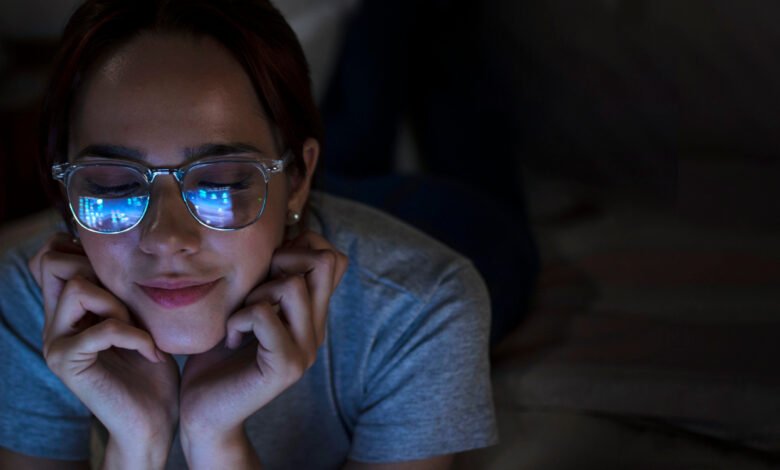How Blue Light Affects Your Eyes in 2023

Do you know how blue light affects your Eyes in 2023? In today’s digital age, our exposure to electronic devices has significantly increased. From smartphones and tablets to computers and televisions, we spend a considerable amount of time in front of screens. However, this prolonged screen time exposes our eyes to a form of light known as blue light. In this article, we will explore the impact of blue light on our eyes in 2023 and discuss effective ways to protect our vision.
As technology continues to evolve, blue light has become a prevalent concern for eye health. Blue light is a high-energy, short-wavelength light that is emitted by both natural and artificial sources. While it plays a crucial role in regulating our circadian rhythm and boosting our mood during the day, excessive exposure to blue light can have adverse effects on our eyes and overall well-being.
Read More: 11 Ways to Get the Best Eye Care in 2023
What is Blue Light?
Natural sources of blue light
Blue light is naturally emitted by the sun and is an essential component of natural light. It helps regulate our sleep-wake cycle and promotes alertness during the daytime. Exposure to natural blue light is crucial for our overall health and well-being.
Artificial sources of blue light
In today’s modern world, artificial sources of blue light are more prevalent than ever. Electronic devices, such as smartphones, tablets, computers, and televisions, emit significant amounts of blue light. Additionally, energy-efficient LED lighting also emits blue light. Prolonged exposure to these artificial sources can lead to various eye-related issues.
Blue Light and Eye Health
Effects of blue light on the Eyes
Excessive exposure to blue light can cause digital eye strain, also known as computer vision syndrome. Symptoms include eye fatigue, dryness, redness, blurred vision, and headaches. Blue light penetrates deep into the eye, potentially damaging the retina over time.
Long-term impact on eye health
Studies suggest that prolonged exposure to blue light may contribute to the development of age-related macular degeneration (AMD), a leading cause of vision loss in older adults. It is believed that the cumulative effect of blue light exposure over time can increase the risk of developing AMD.
Blue Light and Sleep
Disruption of the sleep-wake cycle
One of the significant impacts of blue light on our health is its ability to disrupt our sleep-wake cycle. Exposure to blue light in the evening or at night suppresses the production of melatonin, a hormone that regulates sleep. This can lead to difficulty falling asleep, poor sleep quality, and even insomnia.
Impact on overall sleep quality
Research has shown that exposure to blue light before bedtime can affect the overall quality of our sleep. The artificial blue light emitted by electronic devices interferes with our natural circadian rhythm, making it harder for us to achieve restful and rejuvenating sleep. Over time, poor sleep quality can have detrimental effects on our physical and mental well-being.
Protecting Your Eyes from Blue Light
How Blue Light Affects Your Eyes in 2023
One of the most effective ways to minimize blue light exposure is by reducing our screen time. It is advisable to take regular breaks from electronic devices, especially during prolonged use. Engaging in other activities like reading a book, spending time outdoors, or practicing hobbies can help reduce the strain on our eyes and limit blue light exposure.
Using blue light filters
Blue light filters are specialized screen protectors or software applications that help reduce the amount of blue light emitted by electronic devices. These filters work by blocking or filtering out a portion of the blue light spectrum, making the screen appear warmer and reducing eye strain. Many devices and operating systems now offer built-in blue light filter settings that can be easily activated.
Adjusting display settings
Most electronic devices allow users to adjust display settings to reduce blue light emission. By reducing the screen brightness, enabling night mode, or activating a warm color temperature, you can decrease the amount of blue light reaching your eyes. These simple adjustments can make a significant difference in reducing eye fatigue and minimizing the potential risks associated with blue light.
Blue Light and Digital Eye Strain
Symptoms of digital eye strain
Digital eye strain refers to a group of eye and vision-related problems caused by prolonged screen time. Symptoms include dry eyes, eye fatigue, blurred vision, headaches, neck and shoulder pain, and difficulty focusing. Blue light emitted by electronic devices is a contributing factor to digital eye strain.
Preventive measures
To prevent digital eye strain, it is essential to practice healthy habits while using electronic devices. Position your screen at a comfortable distance and adjust the screen brightness to avoid excessive strain on your eyes. Follow the 20-20-20 rule, which suggests taking a 20-second break every 20 minutes to look at an object 20 feet away. Additionally, consider using lubricating eye drops to alleviate dryness and maintain proper eye moisture.
Blue Light and Children
Increased screen time
Children today are exposed to screens from an early age, and their screen time has increased significantly. This raises concerns about the potential impact of blue light on their developing eyes. The cumulative effect of blue light exposure over time may have long-term consequences for children’s eye health.
Safety guidelines
It is important for parents to set limits on their children’s screen time and encourage healthy habits. Consider using blue light filters or enabling night mode on devices used by children. Encourage outdoor activities and provide alternative forms of entertainment that do not rely on electronic devices. Regular eye check-ups for children can also help detect any early signs of vision problems and address them promptly.
Conclusion
In conclusion, blue light has a significant impact on our eyes in 2023. Excessive exposure to blue light from electronic devices and artificial lighting can lead to various eye-related issues, including digital eye strain, sleep disruption, and potential long-term effects on eye health. However, there are practical steps we can take to protect our eyes. Limiting screen time, using blue light filters, adjusting display settings, and practicing healthy habits can help minimize the negative effects of blue light on our eyes and overall well-being.
Read More: How to Simply Remove Dark Spots Under Eye at Home
FAQs
How does blue light affect sleep?
Blue light suppresses the production of melatonin, the hormone that regulates sleep. Exposure to blue light before bedtime can disrupt our sleep-wake cycle and make it harder to fall asleep or achieve restful sleep.
Can blue light cause permanent eye damage?
Prolonged exposure to blue light may contribute to the development of age-related macular degeneration (AMD), a leading cause of vision loss in older adults. However, it is essential to note that the risk of permanent eye damage from blue light is still being studied.
Are there any benefits of blue light?
Blue light plays a crucial role in regulating our circadian rhythm, boosting our mood, and promoting alertness during the daytime. It is essential for maintaining a healthy sleep-wake cycle and overall well-being.
How can I protect my eyes from blue light?
You can protect your eyes from blue light by limiting screen time, using blue light filters or software applications, adjusting display settings to reduce blue light emission, and practicing healthy habits while using electronic devices.
Should children use blue light filters?
Yes, children can benefit from using blue light filters or enabling night mode on their devices. It is important to set limits on their screen time, encourage outdoor activities, and prioritize their eye health through regular check-ups.







